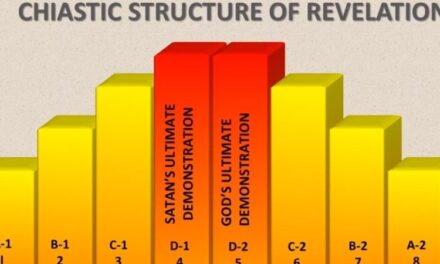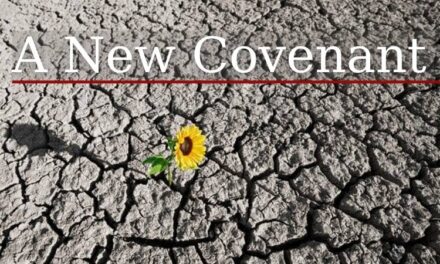Welcome to a Revelation of Jesus. As we continue with the messages of the three angels in Revelation 14 we encounter one of the most out-of-character pronouncements that have ever emanated from our Creator. Although all three messages are framed in the good news of the “everlasting gospel,” the third angel’s message seems at first glance to be an effort to frighten the world into submission: “Then a third angel followed them, saying with a loud voice, ‘If anyone worships the beast and his image, and receives his mark on his forehead or on his hand, he himself shall also drink of the wine of the wrath of God, which is poured out full strength into the cup of His indignation. He shall be tormented with fire and brimstone in the presence of the holy angels and in the presence of the Lamb. And the smoke of their torment ascends forever and ever; and they have no rest day or night, who worship the beast and his image, and whoever receives the mark of his name” (Revelation 14:9-11).
—
Are these the threats of a God who is determined to get His own way? How can we reconcile this message with the equally clear declaration that “God is Love”? (John 4:7,8).
Let’s start by looking at the differences between threats and warnings. There are at least three kinds of threats. The first threatens harm against someone just because of who they are. The threats of the Nazi’s against the Jews during the Second World War fall into this category. The Jews could not do anything to placate the Nazis because their crime was simply being who they were. The third angel’s message cannot be this kind of threat because “God shows no partiality” (Acts 10:34), “He does not want anyone to perish, but everyone to come to repentance. (2 Peter 3:9).
A second category of threats attempts to frighten and coerce people in order to control their behavior. For example, inner city gangs threaten young teenagers that if they don’t join the gang and help with its criminal activities, they will be hurt or killed. The third angel’s message could not be this kind of threat either. A basic characteristic of God is that He does not coerce or force people to obey Him. Jesus said, “Your Father in heaven makes His sun rise on the evil and on the good, and sends rain on the just and on the unjust” (Matthew 5:45). God invites people to decide for themselves if they want to follow Him. He says, “choose for yourself this day whom you will serve” (Joshua 24:15).
There are also threats that people make because they are afraid of someone. The classic line, “come one step closer and I’ll kill you” is an example. It goes without saying that God does not make these kinds of threats; being omnipotent, He is not afraid of anyone.
—
Warnings are sometimes difficult to distinguish from threats. The basic difference between a threat and a warning is that a threat seeks to coerce someone to do what the threatener wants, whereas a warning seeks to prevent someone from doing something harmful or dangerous.
Like threats, there are several categories of warnings. I may warn someone to be careful so he won’t be harmed by something I am going to do. For example, I may issue a warning for people to stay away because I am going to be using dynamite to blast some rock. This kind of warning is prominent in the Book of Revelation. For example, when we study the seven last plagues, we will see that God will intervene to protect His persecuted followers and bring the reign of sin to an end. People who cling to evil and join in Satan’s efforts to destroy God’s followers will themselves be destroyed. God, in His warnings to the world to come into the safety of His protection, uses words like wrath that we usually interpret in human terms. such as being furious or seeking retribution. But God’s wrath, like all that He is and does, is an expression of love. This kind of warning is an integral part of the third angel’s message, and we will be looking at this more closely later in this video.
—
A second kind of warning informs people of the natural consequences of certain kinds of behavior. For example, children are warned not to walk on thin ice or go too close to a hornet’s nest. This kind of warning is also a part of the third angel’s message. It is easy to passively go along with what the majority of people seem to be doing without giving much thought to the consequences. The third angel’s message highlights the prophecies in Revelation that warn of end-time dangers, including the appearance of the antichrist “beast,” so that we can know how to protect ourselves and our loved ones during that perilous time.
Finally, warnings are issued to alert people to the dangers of getting involved with people who have evil intentions. Parents warn their children not to trust strangers, even though they may seem to be nice. This type of warning is central to the third angel’s message. “If anyone worships the beast and his image, and receives his mark on his forehead or on his hand… he shall be tormented with fire and brimstone… and they have no rest day or night, who worship the beast and his image, and whoever receives the mark of his name” (Revelation 14:9-11). Although at first glance this seems to be a threat, it is actually a warning against getting involved with anything connected with the beast.
—
Since the image and mark of the beast are central to the third angel’s message, it would be helpful for you to review videos 45, 46 and 47, which examine the identity and activity of the beast in Revelation 13. To briefly review, there are two beasts in Revelation 13. The seven-headed beast from the sea symbolizes the medieval European union of church and state that brutally persecuted those whom they considered heretics during the Dark Ages. That beast received what John called a “mortal wound” when the Roman Catholic papacy lost power, prestige, and territory during the French and Italian revolutions. But around the same time, a new power came upon the scene: the beast rising out of the earth, symbolizing the United States of America. With its motto “One nation under God” and tolerance of all religions, it appears at first to be more like a lamb, but during the final events it will “speak like a [satanic] dragon” (Revelation 13:11).
—
It is this beast that creates “an image to the beast who was wounded” (Revelation 13:14). Like the first beast, the image to the beast is a union of church and state, in this case, American Christianity teaming up with American democratic government to persecute those Christians who refuse to submit to its demands. In video 46 we looked at scriptural evidence showing that in the context of the violent chaos of the final events, a coalition of religious leaders will assert that God is causing the disasters because the world is desecrating Sunday, His holy day. A worldwide mandate to honor Sunday, enforced by a death decree for those who disobey, will constitute the mark of the beast.
With this review of the beast’s activities during the last days, we can see why God, through the third angel’s message, gives such a stern warning. First of all, this outpouring of God’s wrath is provoked by the worship of the beast: “If anyone worships the beast and his image, and receives his mark ,… he himself shall also drink of the wine of the wrath of God” (Revelation 14:9,10). As we saw in video 51, the Greek and Hebrew words translated “worship” involve homage and submission. In this case, it is submission to the agenda of the beast, which is to destroy God’s faithful followers who refuse to obey the beast’s demands. God will protect His children, even if it means the destruction of those who resolutely seek to harm them. God’s radical protection of His people is called “the wine of the wrath of God, which is poured out full strength into the cup of His indignation” (Revelation 14:10).
—
The third angel’s message goes on to say that those who join with the beast in his diabolical plans “shall be tormented with fire and brimstone in the presence of the holy angels and in the presence of the Lamb. And the smoke of their torment ascends forever and ever, and they have no rest day or night, who worship the beast and his image, and whoever receives the mark of his name” (Revelation 14:10,11). This harsh language is borrowed from the Old Testament.
The phrase “fire and brimstone” is a direct quotation from Genesis 19, the story of the destruction of Sodom and Gomorrah during the time of Abraham. One day, the Lord and two angels came in human form to visit Abraham. Just before they left, “the Lord said, ‘Because the outcry against Sodom and Gomorrah is so great and their sin so grievous, I will go down now and see if what they have done is as wicked as I have heard” (Genesis 18:17-21). Abraham was alarmed because his nephew Lot had moved to Sodom, and he bargained with the Lord not to destroy the city if there were even a few righteous people in it. But when two angels went down to investigate, “the men of Sodom, both young and old, all the people to the last man, surrounded [Lot’s] house. And they called out… ‘Where are the men who came to spend the night with you? Bring them out to us so we can have sex with them!” (Genesis 19:4,5).
—
The depravity of the people of Sodom had pervaded the whole population. They were a danger to visitors, to each other, and especially to their children, who grew up to perpetuate their wickedness. The Lord in his mercy brought Lot and his family out of the city and “then the Lord rained fire and brimstone on Sodom and Gomorrah… when God destroyed the cities of the plain, He remembered Abraham, and sent Lot out when He overthrew the cities” (Genesis 19:24, 29). Here we see that fire and brimstone are the means of destruction of those who, for their own sakes and for the sakes of those they harm, should not continue to live.
Fire and brimstone is confirmed as a symbol of righteous destruction in Psalm 11. “The Lord is on his heavenly throne. He observes everyone on earth; The Lord tests the righteous, but… upon the wicked and the ones who love violence…. He will rain fire and brimstone (Psalm 11:4-6). Jesus Himself said “On the day that Lot went out of Sodom it rained fire and brimstone from heaven and destroyed them all. Even so will it be in the day when the Son of Man is revealed” (Luke 17:29). The fact that Jesus included fire and brimstone as a part of His second coming shows us that even this scary scenario is an act of grace, mercy, and love.
—
Fire and brimstone is an integral part of God’s judgment. We saw in video 49 that the judgment is good news, bringing sin, oppression, and death to an end. But in doing so the judgment also involves the destruction of those who refuse to let go of sin. In the final phase of the judgment John “saw the dead, small and great, standing before God… and the dead were judged, each one according to his works… and anyone not found written in the Book of Life was cast into the lake of fire… the cowardly, unbelieving, abominable, murderers, sexually immoral, sorcerers, idolaters, and all liars shall have their part in the lake which burns with fire and brimstone; this is the second death” (Revelation 20:12-15, 21:8).
Considering all the texts about fire and brimstone that we have looked at, we can see that it is a symbolic way of indicating the flip side of God’s judgment that we looked at in the first angel’s message. That message invites the world to “fear God and give glory to Him, because the hour of His judgment has come,” an hour when anyone can choose to leave their life of sin and secure a place in God’s everlasting kingdom. But the third angel’s message warns the people of the world that rejecting God’s invitation and joining in Satan’s beast coalition that is trying to destroy God’s followers will leave them on the wrong side of the judgment. Destruction will result, both at the Second Coming and at the final judgment when the “second death” ensures that “there will be no more death, nor sorrow, nor crying. There shall be no more pain, for the former things have passed away” (Revelation 21:4).
—
This interpretation is quite different from the “fire and brimstone” of eternal torment that has been a part of the teaching of some Christian churches. An eternity of torment as punishment for a lifetime of sin is an affront to our sense of justice, and I will deal with this thoroughly when we get to chapter 20; if you would like to read about it in advance, I will include a link to an article below in the description. But needless to say, the fearsome and confusing language of the third angel’s message has been used to support the doctrine of eternal torment. “They shall be tormented with fire and brimstone… and the smoke of their torment ascends forever and ever; and they have no rest day or night, who worship the beast” (Revelation 14:10,11).
In lieu of the complete study that I just mentioned, I would just encourage you not to read anything into this text that is not there. The fact that impenitent sinners shall be “tormented with fire and brimstone” is in harmony with Revelation 20:15: “Anyone not found written in the Book of life [will be] cast into the lake of fire.” This is simply the fire that destroys sinners for eternity, even as Jesus said in Matthew 10:28, “Fear Him [that is, God] who is able to destroy both soul and body in Hell” (Matthew 10:28). Jesus only allows people to lose their soul and body because they could not be happy living forever with Him.
—
The only thing that is eternal in the third angel’s message is “the smoke of their torment” which “ascends forever and ever.” This phrase also appears in Isaiah 34, which uses parallel language to depict the fiery destruction of the nations that oppose God’s people. As in the third angel’s message, Isaiah 34 describes the fire and brimstone that shall not be quenched night and day, and smoke that ascends forever, reducing the earth to a barren wilderness. But as the story continues in Isaiah 35, God transforms the wilderness into a lush paradise which obviously will not keep on burning. This shows that eternally rising smoke does not equate with eternal burning. Perhaps the smoke, rising forever through the empty vastness of outer space, will provide an eternal memorial to the deadly malignancy of sin.
—
There is one more phrase that we need to examine: “They have no rest day or night, who worship the beast and his image” (Revelation 14:11). Notice that it does not say that they who have worshiped the beast in the past will have no rest in the future. The Greek grammatical form indicates that it is while they are worshiping the beast that they do not have rest. By studying what the Bible says about rest, we will see that God definitely does not want to take away people’s rest and sleep by torturing them forever.
The first rest mentioned in the Bible was by God Himself when He finished His creation and rested on the seventh day. God promised His followers that they too could rest from their labors, enshrining the weekly Sabbath rest in the heart of the Ten Commandments. When His people were out in the harsh desert, fleeing from their taskmasters, God promised that they would have a “place of rest, the land the LORD your God is giving you as your special possession… He will give you rest from all your enemies round about, so that you will dwell in safety” (Deuteronomy 12:9,10).
—
Through the leadership of Joshua “the LORD gave them rest on every side, just as he had solemnly promised their ancestors” (Josuah 21:44). But that rest proved to be temporary and elusive; the book of Hebrews tells us that because of unbelief they did not really enter in to God’s rest, even though they took possession of the land (Hebrews 3:18,19). Hebrews goes on to tell us that the rest that they rejected is still waiting for us. “There remains therefore a sabbath-rest for the people of God. For he who has entered His rest has himself also ceased from his works, as God did from His” (Hebrews 4:9,10).
The book of Hebrews is a letter to the Jewish people which spends a lot of time telling them about the things that have changed now that Jesus the Messiah has come. Hebrews chapters 9 and 10 informed them that there are now no more sacrifices, because God in Jesus sacrificed Himself so that we can have eternal life (Hebrews 9:11-15, 23-28, 10:1-10). Hebrews chapters 7 informed them that there are no more human priests because Jesus is now our great high priest, interceding for us at the right hand of the Father (Hebrews 6:19-8:2). Hebrews chapter 9 informed them that the temple is now obsolete because Christ is ministering in the “greater and more perfect tabernacle not made with hands” (Hebrews 9:11) Hebrews 9:1-11). Hebrews also informed them that the ceremonial law was done away with (Hebrews 7:11,12), along with the old covenant (Hebrews 8:7-13). These were all symbolic representations, or as Hebrews says, “a shadow of the good things to come” (Hebrews 10:1).
—
But one thing that didn’t become obsolete was the rest that God offers His followers. “So then, a sabbath-rest still remains for the people of God” (Hebrews 4:9). The Greek word sabbatismos means the keeping of the Sabbath. That is because the Sabbath is a weekly symbolic reminder that Jesus has accomplished and finished all that is necessary for our salvation, and He simply invites us to enter into His rest. Jesus said, “Come to me, all you that are weary and are carrying heavy burdens, and I will give you rest (Matthew 11:28).
In the third angel’s message, Jesus gives a warning that is actually an invitation to all who are weary of trying to carry the beastly burdens of this world, burdens that will become unbearable when Satan, the final beast, arrives in person on the scene. Jesus, through His angel messengers, tells the world that there is no rest when they worship or submit to the beast. The beast system is all about deceived people trying to placate a demanding God, and teaming up to try to force everyone else to submit, so that “God” will stop punishing the world. Jesus says, “No. I’m not like that. Come to Me, lay your burdens down, and enter into My rest.
—
If you were blessed by this video, I would appreciate it if you would like it, share it with someone, and subscribe to my YouTube channel; that really encourages me to keep on making more videos.
Order the book “A Revelation of Jesus”
A Revelation of Jesus by David Lackey is available from Barnes and Noble (free shipping), Amazon, and many other bookstores.
ISBN-13: 978-1479603923










